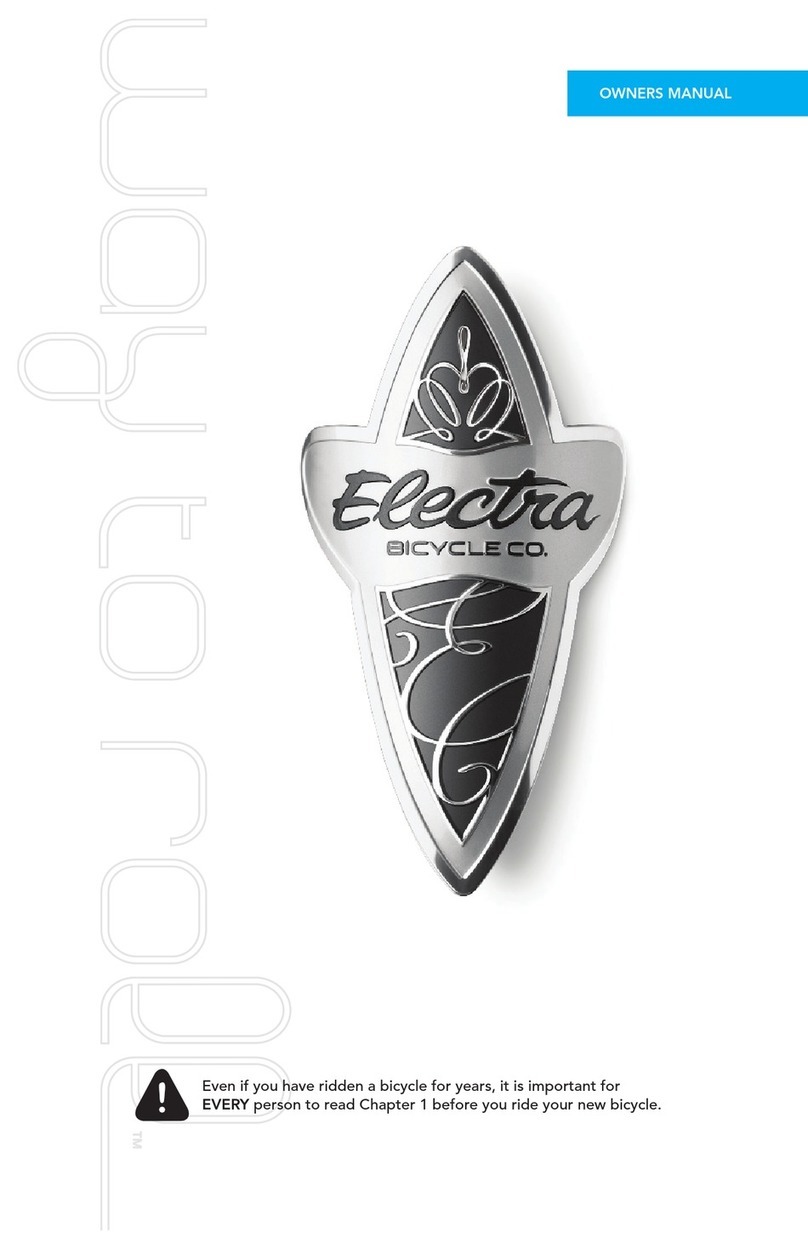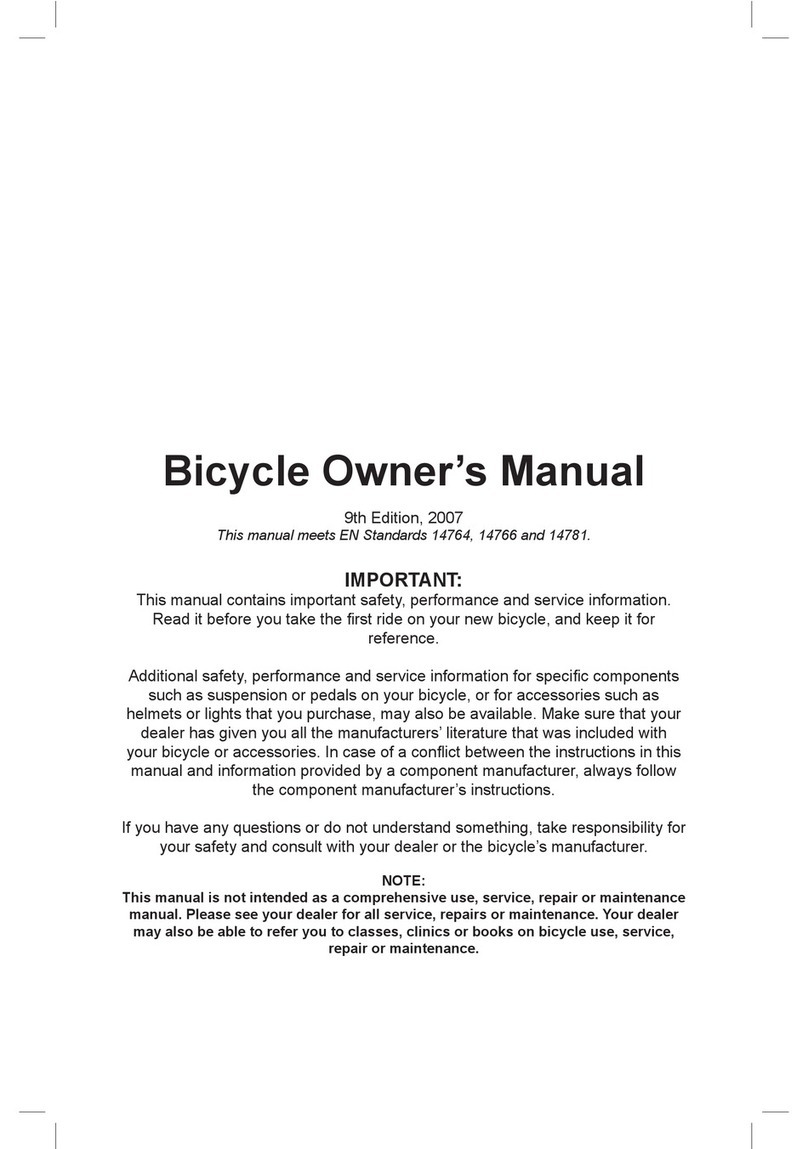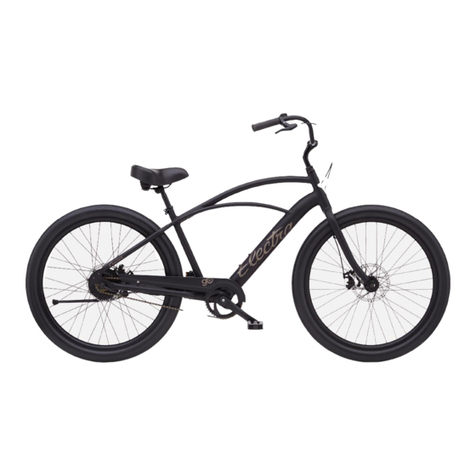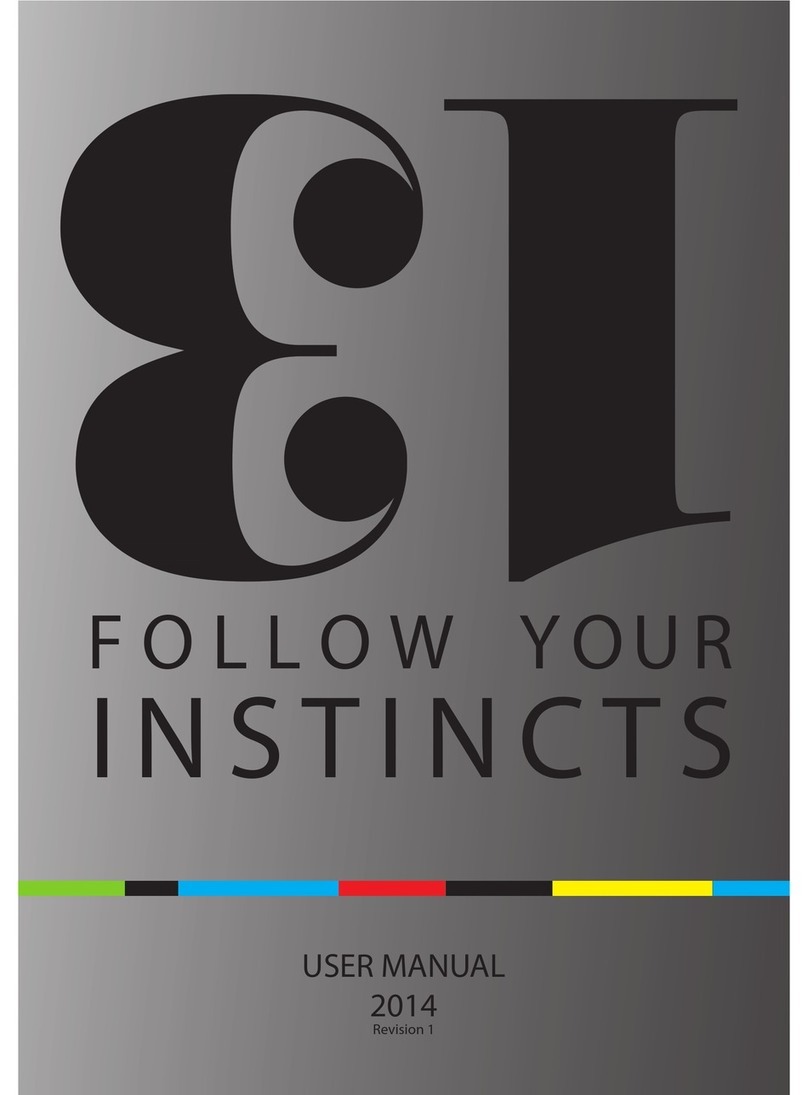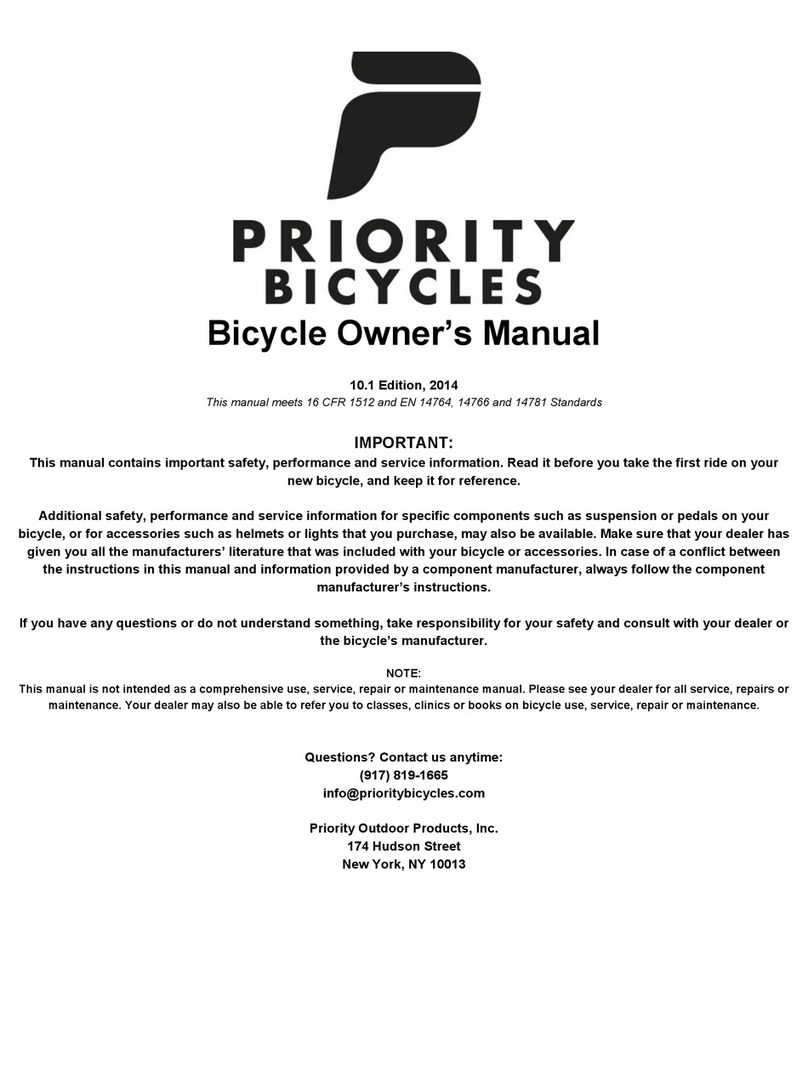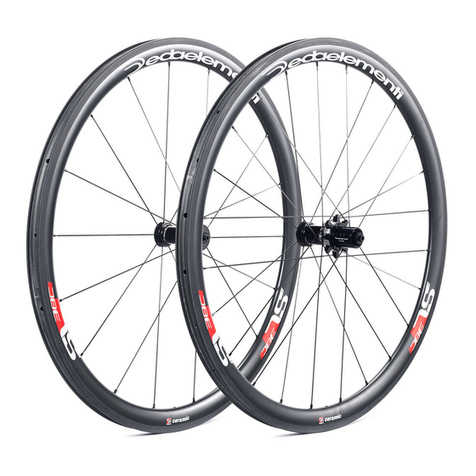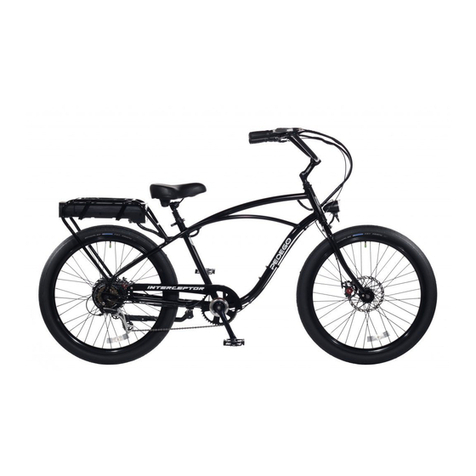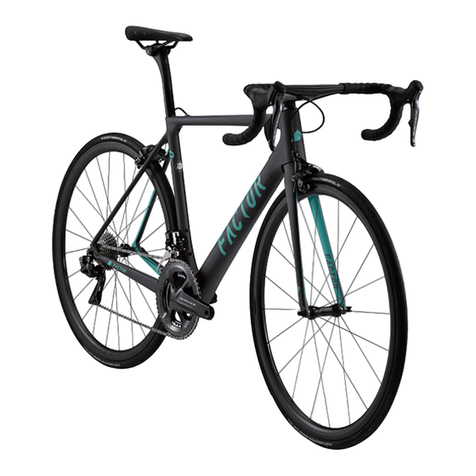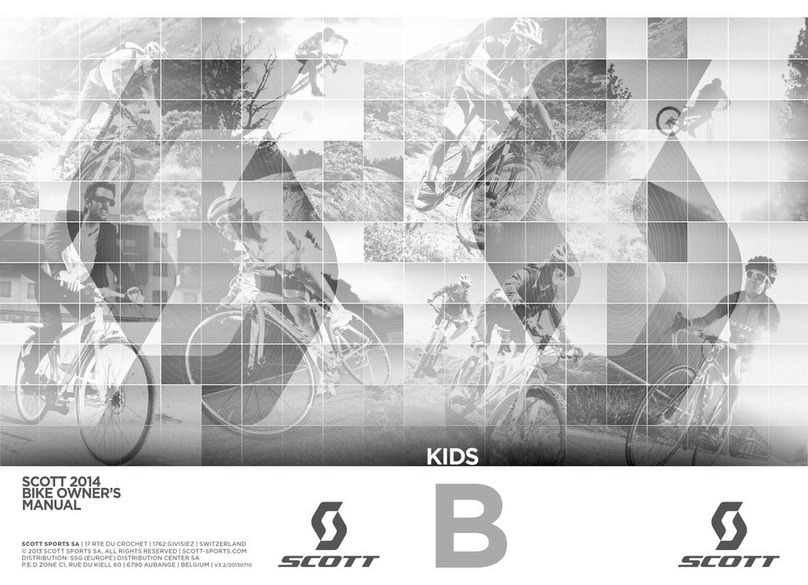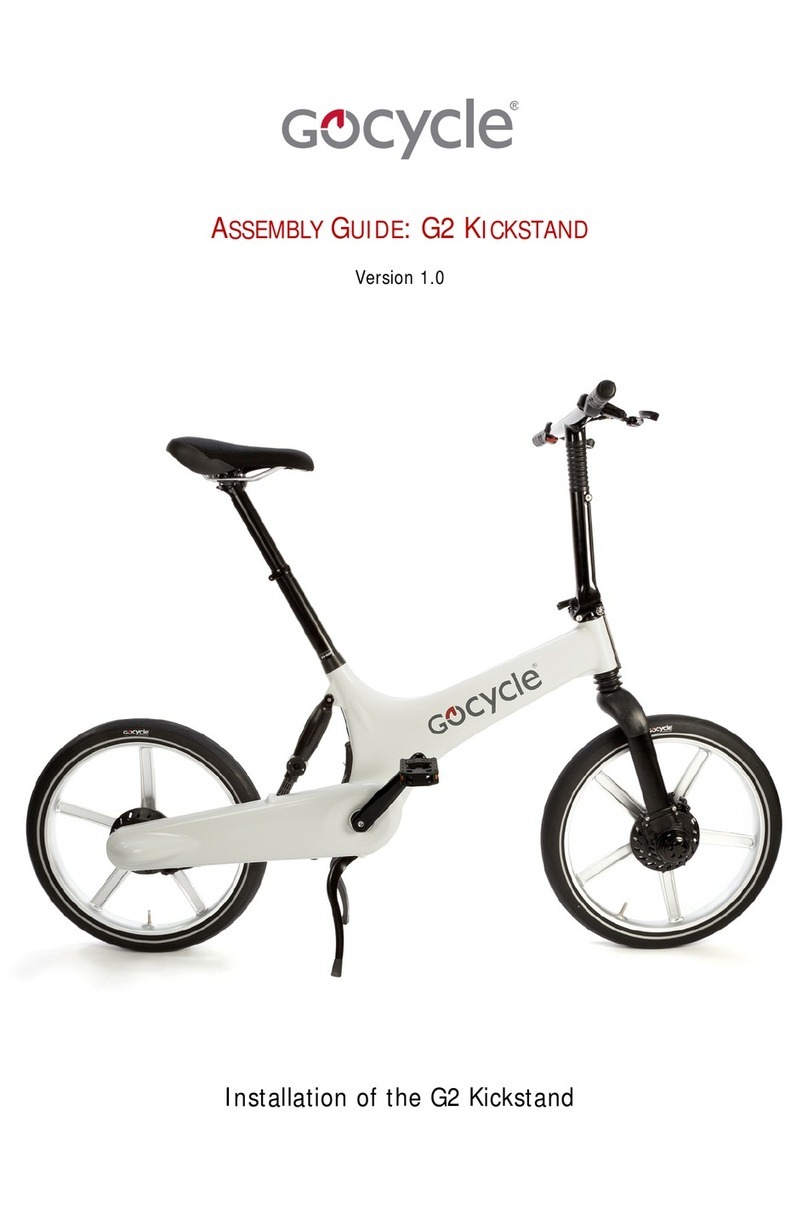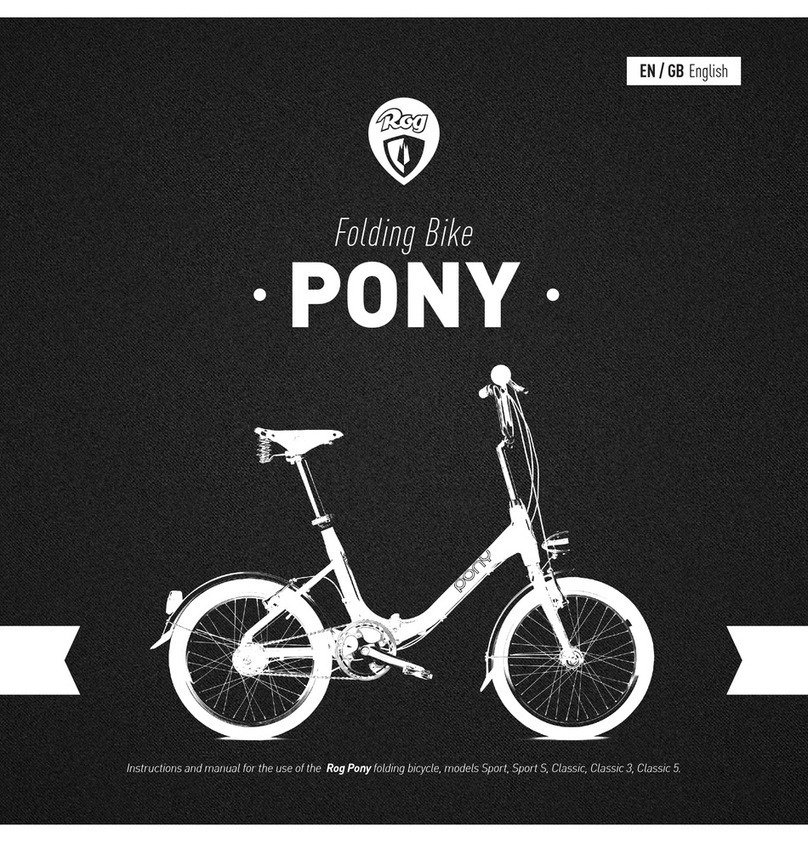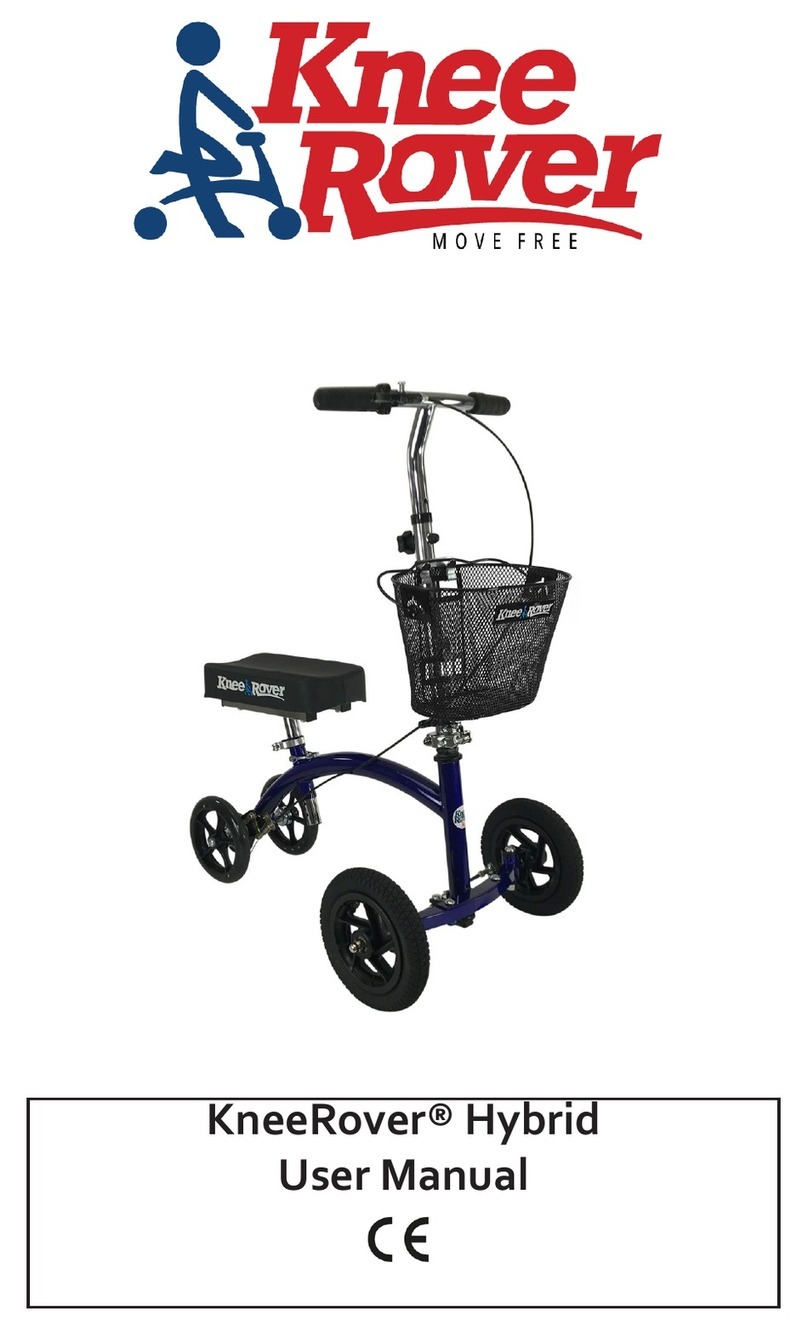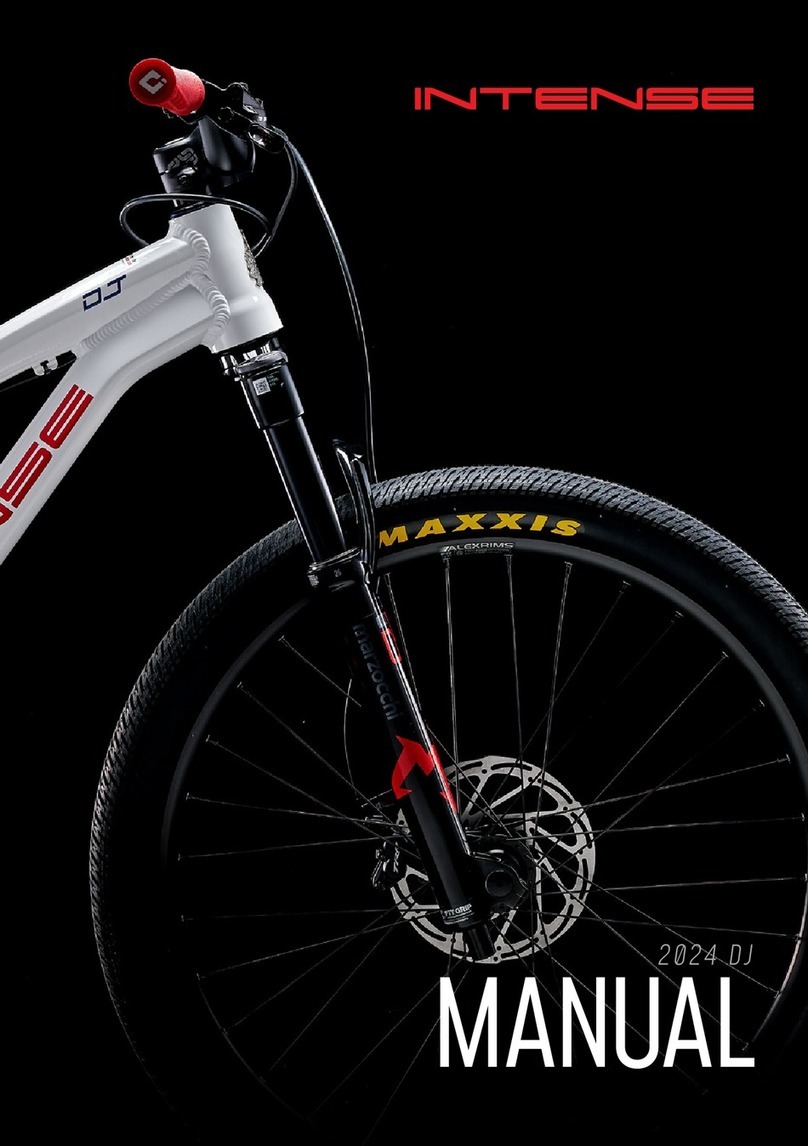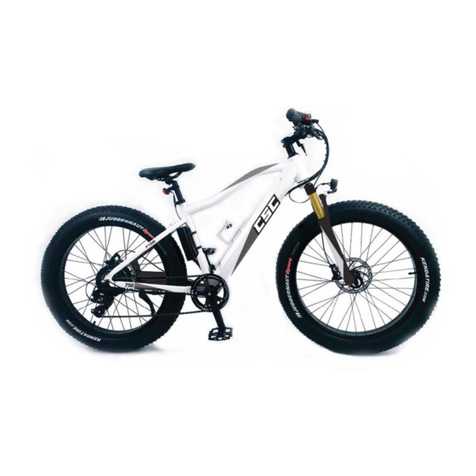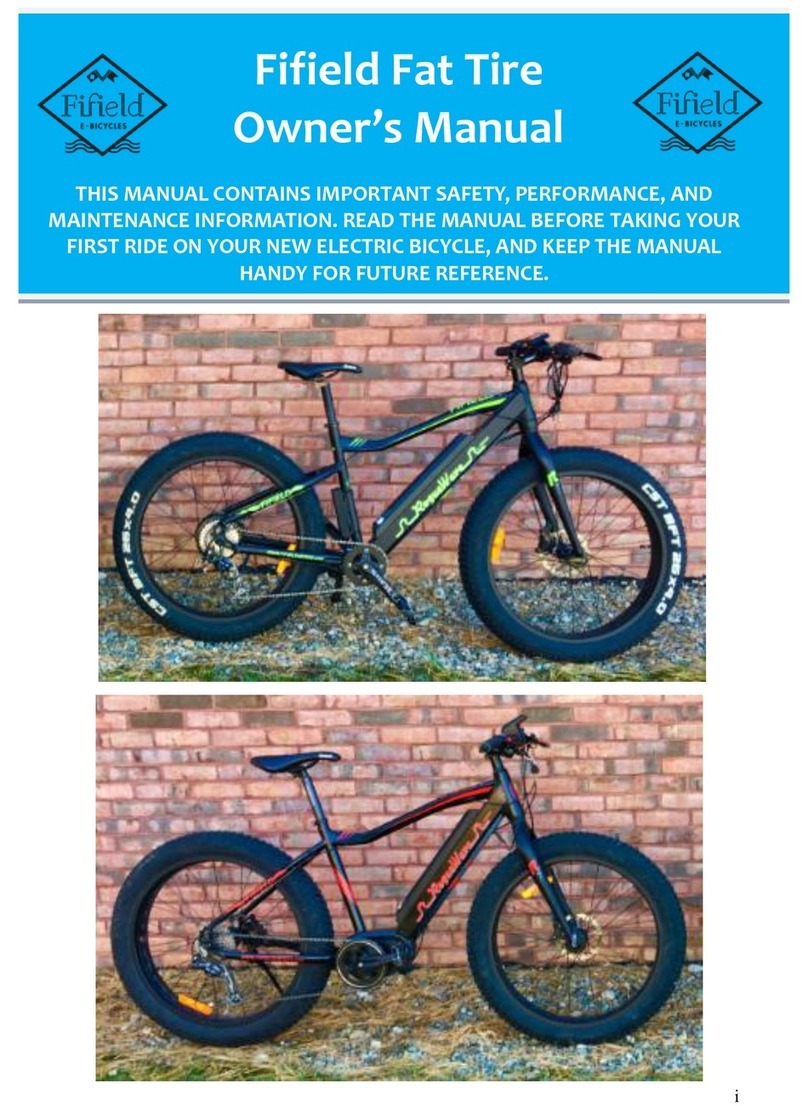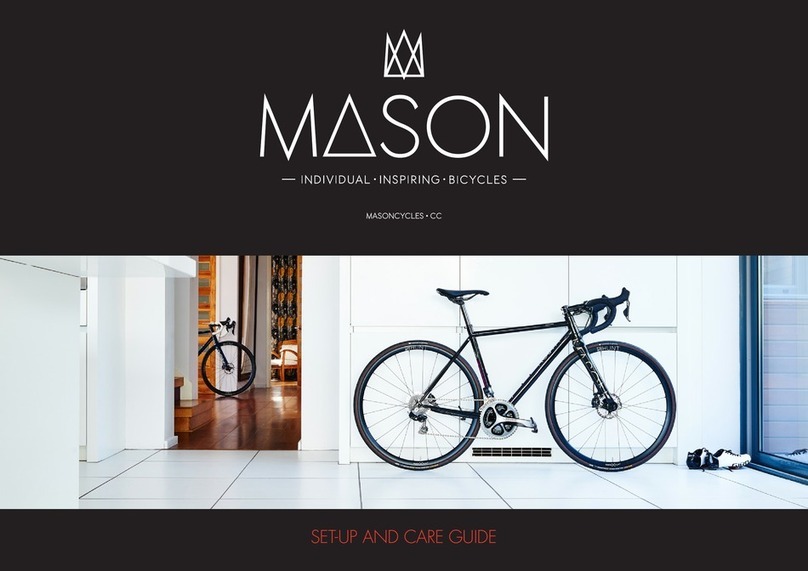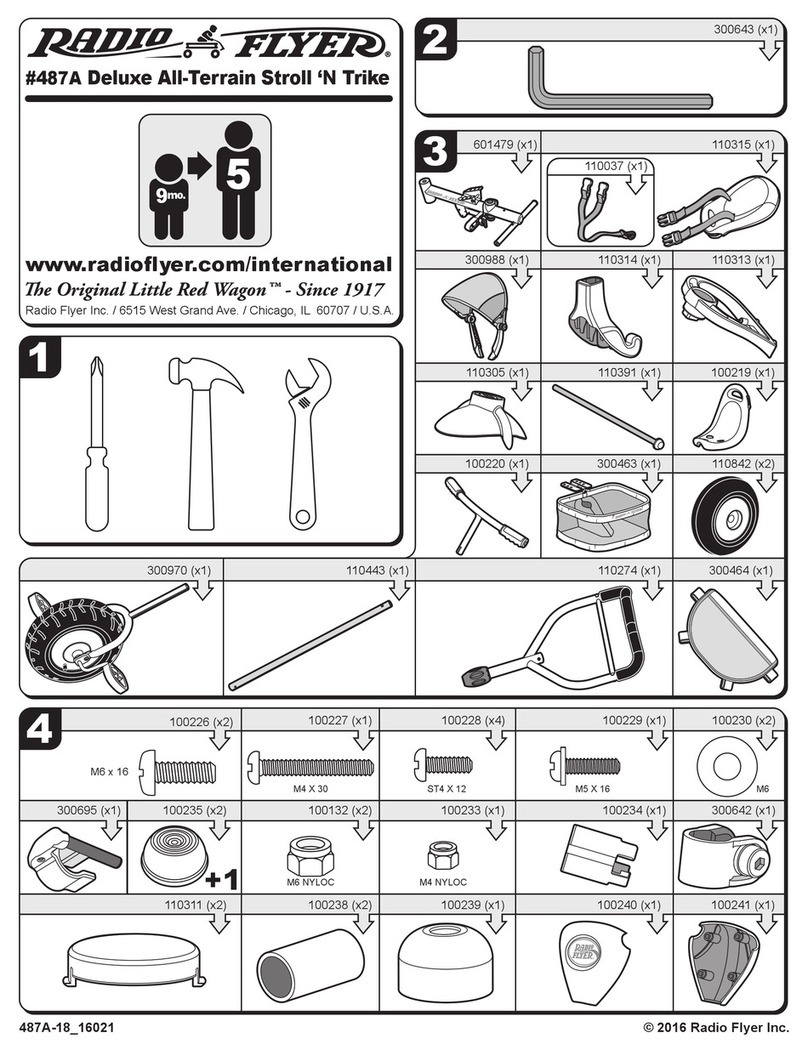Electra Townie Series User manual

READY.
GO!
Wait, read this real quick.

C1
Here are some tips to help you enjoy your new ride.
Check, check. 1-2, 1-2.
Before you get on your bike, give it the once over and make sure your tires are
properly inated and the front wheel is secure. Nothing ruins an awesome wheelie like
losing a wheel. If you’re not sure how the wheel attaches, the details are inside.
We like that brain of yours, protect it.
We know, helmet hair, right? But you know what looks lamer? Concussion hair.
Besides, we’ve got a sweet line of helmets to match your bike.
Avoid things that can get stuck in your front wheel.
A shopping bag in your hand, a purse, rogue sticks. If something gets jammed in there
and the front wheel stops suddenly, you’re going to have a bad time.
Use bike lights on every ride, day and night.
Use them all the time. It’s just like driving these days. People smarter than us have
done studies showing lights are the single best way to stand out to motorists, even
when the sun is shining.
Something sounds or feels weird? Get it checked out.
Just like planes, bikes are easier to x before you take off. Electra retailers are there
to help.
Like a fender after rain, we’ve got your back.
If you ever have a problem your local Electra shop can’t solve, reach out to:
customercare@electrabike.com or write Electra President Kevin Cox directly at
kc@electrabike.com.
Read the rest of this manual.
Sounds like homework, but it’s worth it. 25 years on the streets have taught us a lot
of stuff worth sharing.

23
First things rst
We know you want to get out there and ride. Before you do,
it’s important that you complete steps 1 & 2 below.
They won’t take long.
1 Register your bike
Registration records your serial number (which is important if your bike is
ever lost or stolen), and serves as a means of communication with Electra
if there are any safety alerts about your bicycle. If you have questions about
your bicycle, even years down the line, in just seconds your registration lets
us know exactly which bike we’re discussing, so we can give you the best
service possible.
If you or your bike shop haven’t already registered your bike,
please do so in the Support section at the top of the home page at
electrabike.com. It’s quick and easy.
2 Read this manual
This manual contains essential safety information. Even if you’ve
ridden a bicycle for years, it’s important that you read and
understand the information in this manual before riding your new
bicycle. You can read it here or online in the Support section at the
top of the home page at electrabike.com.
Parents or guardians, if this bicycle is for a child or dependent, please make
sure he or she understands all safety information in this manual.
How to use this manual
This manual covers all Electra bicycle models. It contains useful
information for the life of your bicycle.
Read the fundamentals
Read Chapter 1, Fundamentals, before you ride your bike.
If you purchased an electric-assist bicycle (e-bike), please also read the
supplemental Electric Bicycle Owner’s Manual. It’s also available in the
Support section of electrabike.com.
Go online for more great info
You’ll nd the most current and detailed information at electrabike.com.

45
Keep this manual for reference
This manual shows you how to ride safely, and how and when to
do basic inspections and maintenance (Chapter 2). Keep it for the life of
your bicycle. We also recommend that you keep your proof of purchase
along with the manual in case you need to make a warranty claim.
Translations are available in the Support section under Owner & Tech manuals at
electrabike.com.
es Puedes consultar este manual traducido en tu idioma en electrabike.com
it Puoi trovare la versione italiana di questo manuale sul sito electrabike.com
pt Você pode consultar este manual traduzidos no seu idioma em
electrabike.com
da For dansk manual gå da venligst til electrabike.com
no Du nner denne manualen på norsk på electrabike.com
sv Översättning av denna manual i ditt eget språk hittar du på electrabike.com
Tämän ohjeen löydät omalla kielelläsi osoitteesta electrabike.com
ru Вы можете найти английскую версию этого руководства на этом сайте
electrabike.com
de Sie können die deutsche Version dieses Handbuchs auf dieser Site nden
electrabike.com
he electrabike.com הז רתאב הז ךירדמ לש תירבעה הסריגה תא אוצמל ןתינ:
ar يمكنك التحقق من هذا الدليل المترجم بلغتك على electrabike.com
sl Slovenská verzia tejto príručky nájdete na stránke electrabike.com
If you’d like a printed, translated manual, the shop where you purchased your
bicycle can provide one for you.
This manual complies with these standards: ANSI Z535.6; AS/NZS 1927:1998,
CPSC 16 CFR 1512, ISO 4210-2 and ISO 8098.
A note about warnings
As you read this manual, you’ll see gray warning boxes like this:
WARNING! Text in a gray box with the safety alert symbol will warn you about a
situation or behavior that could cause severe injury or death.
The reason for these warnings is that we don’t want you — or your loved ones,
or your bicycle — to get hurt.
We want you to have fun on your bicycle, just like we love to have fun on
our bicycles.
We know what it’s like to tip over at a stop sign, to bloody our knuckles while
xing a chain, to crash on slick pavement. We’ve done it all. At best, those
mishaps aren’t fun. At worst, you could get hurt.
So please pay attention to the warnings. It’s our way of letting you know we care
about your safety.

7
Important safety information
Read this important safety information before riding your bicycle.
A bicycle can’t protect
you in an accident
The most common cause of injury on a
bicycle is falling. In a crash or impact,
it is not uncommon for your bicycle
to sustain damage and for you to fall.
Cars have bumpers, seat belts, air
bags, and crumple zones. Bicycles
do not. If you fall, your bicycle cannot
prevent injury.
If you are involved in any kind of
impact, crash, or accident, check
yourself thoroughly for injuries.
Then have your bicycle thoroughly
inspected by your bike shop before
you ride it again.
Know your limits
A bicycle can be dangerous, especially
if you try to ride beyond the limits of
your ability. Know your skill level and
don’t ride beyond it.
Know your bike’s limits
Use conditions
Your bicycle is made to withstand
the stress of “normal” riding within
specic use conditions (see Use
conditions section). If you misuse
your bicycle by riding outside those
conditions, it can be damaged by
stress or fatigue (You’ll see the word
“fatigue” frequently in this manual. It
means the weakening of material over
time due to repeated load or stress.).
Any damage can drastically reduce the
life of the frame, fork, or other parts.
Lifespan
A bicycle is not indestructible, and
its parts will not last forever. Our
bicycles are made to withstand the
stress of “normal“ riding because
those stresses are well known
and understood.
Fundamentals
7 Important safety information
10 Important e-bike information
10 Get to know your bike shop
12 Bike diagram
14 Before your rst ride
16 Before every ride
20 Safety precautions
24 Use conditions & weight limits
26 Basic riding technique
31 Riding with a child
CHAPTER 1

8 9
However, we cannot predict the forces
that might occur if you ride in extreme
conditions, if it is involved in an
accident, if it is used for rentals or for
commercial purposes, or if it is used
in other ways that apply high stress or
fatigue loads.
With damage, the life of any part can
be drastically reduced and may fail
without warning.
The safe life of a part is determined
by its construction, materials, use,
maintenance, rider weight, speed,
terrain, and environment (humidity,
salinity, temperature, etc.), so it is not
possible to give an accurate timetable
for replacement.
Any crack, scratch, or change of color
in a high-stress area indicates the
part (including the frame or fork) has
reached the end of its life and should
be replaced. If you are not sure or you
don’t feel comfortable inspecting or
repairing your bicycle, consult your
bike shop.
In some cases, a lighter frame
or part has a longer life than a
heavier one. However, regular
maintenance, frequent inspections,
and frequent replacement of parts
are necessary for any bicycle.
WARNING: A bicycle is subjected
to wear and high stress. Different
materials and parts may react to wear
or stress fatigue in different ways. If the
design life of a part has been exceeded,
it may suddenly fail.
For a maintenance schedule, see the
Caring for your bike section.
Handle with care
Some parts of your bicycle can injure
you if mishandled. There are sharp
points, for example, on the teeth
of the chainrings and some pedals.
Brakes and their parts get hot.
Rotating wheels can cut skin and even
break bones. Clamps and pivoting
parts such as brake levers can pinch,
as can the chain where it runs onto
sprocket teeth.
E-bike components are especially
vulnerable. Electric cables,
connectors, battery dock, battery, and
the controller can be easily damaged if
handled incorrectly.
Think safety
Stay tuned to your environment and
avoid dangerous situations which are
usually obvious (trafc, obstacles,
drop-offs, and so on), but sometimes
are not. Many of those situations are
shown in this manual.
Some of the high-risk stunts and
jumps seen in magazines or videos are
very dangerous; even skilled athletes
get severe injuries when they crash
(and they do crash).
Modications to your bicycle can
make it unsafe. Each part of your new
bicycle has been carefully chosen and
approved. The safety of accessory
or replacement parts, and especially
how those parts attach and interface
with other parts of the bicycle, is not
always apparent. For this reason, you
should only replace parts with original
equipment or parts that are approved.
If you are not sure what parts are
approved, ask your bike shop.
Examples of modications include this
partial list:
• Physically altering existing parts
(sanding, ling, drilling, etc.)
• Removing safety equipment such
as reectors or secondary retention
devices
• Using adapters for brake systems
• Adding a motor or engine
• Installing accessories
• Changing parts

10 11
Knowledgeable staff
Bike shop staff aren’t just sales-
people. They’re riders who use and
understand the products they sell.
The right t
Your shop can set up and adjust your
bike to t you, your riding style, and
your preferences.
Professional mechanics
Service staff at your shop will keep
your bike or e-bike in tip-top shape
season after season.
Warranty service
If you have an issue with a product we
sell, your bike shop is committed to
making it right.
There’s a shop for
every rider
We work with over 2,000 local bike
shops in the U.S. and hundreds
more worldwide. While some dealers
specialize in performance bikes,
Electra retailers offer something for
everyone. It’s all about getting on
bikes and enjoying the ride.
If you don’t already have a favorite
shop, the best place to nd one is
Find a retailer at electrabike.com.
Important e-bike information
It is important to read this manual and the supplemental
Electric Bicycle Owner’s Manual carefully before you ride your
new electric bike.
• There’s good stuff in each manual
about your e-bike.
• We’re partners in protecting the
earth, so you need to properly use,
maintain, and dispose of electrical
components.
In addition to the operation of your
e-bike section, we recommend you
read the Important to read before the
rst ride section of the supplement.
Get to know your bike shop
The best way to ensure many happy hours of trouble-free cycling is to
build a relationship with your favorite bike shop.
The ultimate resource
This manual contains lots of valuable
information about your bicycle — and
there’s even more in the Support
section of electrabike.com.
But a manual or a website can’t x
a at, tune your derailleur, correct
your saddle height, pour you a cup of
coffee, or wax endlessly about that
one time when you almost won that
one thing.
Locally owned bike shops are the
heart and soul of cycling. Here’s just a
sampling of what they offer:

12 13
Bike diagrams
1 Saddle
2 Seat post
3 Seat post clamp
4 Seatstay
5 Seat tube
6 Pedal
7 Rear derailleur
8 Front disc brake
9 Rear disc brake
10 Front rim brake
11 Rear rim brake
12 Cassette
13 Chainstay
14 Chainring
15 Crank arm
16 Rim
17 Spoke
18 Tire
19 Hub
20 Down tube
21 Fork
22 Head tube
23 Shifter
24 Brake lever
25 Handlebar
26 Stem
27 Headset
28 Top tube
These diagrams include basic bike parts. Your specic model may not have all the parts
shown. Visit the Support section of electrabike.com for more specic information.
29 Rack
30 Front fender
31 Rear fender
32 Front light
33 Rear light
34 Motor
35 Kickstand
36 Control unit
37 Battery
38 Chain guard
39 Ring lock
1
2
3
4
5
789
10
11
12
13
14
15
16
17
18
19
20
21
22
23
25
26
24
27
28
6
29
31
32
30
33
34
35
38
39
36
37

14 15
To avoid damage to the seatpost or
bike frame, do not position the saddle
beyond the minimum insertion line
on the seatpost or seatmast (Figure
1.2). If you can’t properly position your
saddle, see your bike shop.
Adjust your handlebar and
stem to a comfortable height
Handlebar position is important for
control and comfort. You point the
handlebar and the bike follows.
Special tools and training are
necessary to align, adjust, and torque
your stem, so only your bike shop
should do this. Do not attempt to
make the adjustments yourself
as these changes may also require
adjustments to the shift levers, brake
levers, and cables.
WARNING: An incorrect headset
and stem assembly, and incorrect
torque can cause damage to the fork’s
steerer tube, possibly causing the tube
to break. If the steerer tube breaks, you
could fall.
Get to know your bike
For the most possible enjoyment from
your bicycle, familiarize yourself with:
• Pedals
• Brakes (levers or pedals)
• Shifting (if equipped)
You will enjoy yourself more if you have
a comfortable and condent ride.
Figure 1.2: The seatpost minimum
insertion line.
Before your rst ride
It’s extremely important to make sure your bicycle is adjusted and
ready for use before your rst ride.
Ride the right size bike
Almost all Electra models feature our
patented Flat Foot Technology® frame
geometry. One size typically ts most,
but your shop will help you nd the
Electra bicycle that ts you best.
Raise or lower the saddle to a height
that allows you to slightly touch the
ground at-footed while supporting
your entire weight on the saddle. Make
sure your legs are in a straight vertical
position and your knees are NOT bent
(Figure 1.1). In most cases, this will
give you proper riding leg extension. If
you prefer more extension, raise the
saddle slightly.
Stay within the weight limit
Your bicycle has a weight limit.
See the Use conditions section
for general guidelines.
Figure 1.1: Correct ride height.

16 17
Check the wheels
• Check rims and spokes for damage.
Give the wheel a spin. It should spin
straight through the fork (front) and
chainstays (rear), and not contact the
brake pads (rim brakes).
• Check that the axles are fully seated
in the dropouts.
• Lift your bicycle and hit the top of
the tire with a solid blow. The wheel
should not come off, be loose, or
move from side to side.
• If your wheel is equipped with a
quick-release, make sure the lever is
properly closed and positioned
(in-line with the chainstay or front fork)
and does not interfere with the spokes
or disc brake system as the wheel
rotates (Figure 1.4).
WARNING: Securely clamping the
wheel with a quick release system takes
considerable force. If the wheel is not
properly secured, the wheel can become
loose or fall off causing serious injury.
The nut should be tightened enough
that you need to wrap your ngers
around the fork to close the lever. The
lever should leave a clear imprint in your
palm, and the fastener should emboss
the surface of the dropout.
Check the tires
• Use a tire pump with a gauge to
make sure your tires are inated within
the recommended pressure range.
Do not exceed the pressure limit as
stated on the side of the tire or rim;
whichever is lowest.
NOTE: It is better to use a hand or foot
pump than a service station pump or
electric compressor. The latter are more
likely to allow for over-ination, which
can cause the tire to blow out.
Figure 1.4: An incorrectly positioned quick
release lever can interfere with the brake
system.
Before every ride
Before riding your bicycle, perform a safety check on level
ground and away from trafc. If any part doesn’t pass the
safety check, x it or have your bike serviced before riding.
Pre-ride checklist
Check the handlebar
• Make sure the bar is at 90 degrees
to the wheel (Figure 1.3).
• Check that the handlebar is
tightened sufciently so that it will not
twist out of alignment and does not
rotate in the stem.
• Make sure that no cables are pulled
or caught when you turn the handlebar
from side to side.
Check the saddle and
seat post
• Make sure the saddle is in line with
the center of the bike (Figure 1.3).
• Check that the saddle rails or collar
is tightened sufciently so that it will
not twist out of alignment, or move or
tilt up and down.
WARNING: A wheel attachment
device, including a quick-release, not
correctly adjusted and closed can move
independently and catch in spokes or a
brake rotor. In addition, the wheel may
become loose or come off, suddenly
stop the wheel, decrease your control,
and cause you to fall. Make sure your
wheel is correctly installed and rmly
attached before you ride your bicycle.
90º
Figure 1.3: Proper alignment of handlebar
and saddle.

18 19
• Coaster brake: There should be
between 6-12mm (0.25-0.50 in) total
vertical movement in the middle of the
chain (Figure 1.6).
Check the cables
• Make sure all cables and housings
are properly secured to the frame or
fork so that they cannot interfere with
or get caught on moving parts.
Check reectors, lights,
and accessories
• Check that reectors are clean and
correctly positioned on the wheel.
• Make sure your front and rear
lights and any other accessories are
securely attached, properly positioned,
and working properly.
• Position your lights parallel to
the ground. Make sure your batteries
are charged.
Check your e-bike battery
and controller
• With an e-bike, check that your
battery is locked in the dock and fully
charged, and your controller and e-bike
system are functioning properly.
Check your pedals
• Make sure your pedals and shoes
are clean and free of debris that could
affect your grip or interfere with the
pedal system.
• Grab your pedals and crank arm and
wiggle to see if there’s any looseness.
Also spin the pedals to make sure they
rotate freely.
Check the brakes
• While standing still, make sure you
can apply full braking force without the
brake lever touching the handlebar.
(If the lever touches, your brakes may
need adjustment.)
• Check that the front wheel brake
is working properly. Ride the bike at
slow speed and apply the front wheel
brake. The bike should come to an
immediate stop.
WARNING: Brake force applied
to the front wheel suddenly or too fully
could lift the rear wheel off the ground.
This could decrease your control and
cause you to fall. For best results,
apply both brakes at the same time.
(Figure 1.5)
• For rim or disc brakes, repeat the
process with the rear wheel brake.
• For coaster brakes, start with
the back pedal crank slightly higher
than horizontal. Apply pressure
downwards on the back pedal. When
you move the pedal downward, the
brake should engage.
Check the chain
• Make sure your chain or belt has the
correct tension so that it can’t fall off.
If you’re unsure of the correct tension,
see your bike shop.
• Check that the chain has no kinks,
rust, broken pins, plates, or rollers.
Figure 1.5: Apply both brakes together. Using
the front brake only could cause the bike to
pitch forward.
Figure 1.6

20 21
Ride smart
Know your skill level and do not ride
above it.
• Do not ride distracted. Using a
mobile phone, music player, or
similar device while riding can lead
to an accident.
• Do not ride too fast. Higher speed
creates higher risk, and results in
higher forces if a crash occurs.
You may be surprised at the power
of an e-bike.
• Do not ride hands-free. Always keep
at least one hand on the handlebar.
• Do not ride double except on a
tandem bicycle.
• Do not ride while intoxicated or while
using medications that can make you
drowsy or less attentive.
• Do not ride in large groups. Riding
close to other riders reduces visibility
with the road and can cause you to
lose control of your bicycle. Also, large
groups of cyclists can cause problems
for other users of the roadway.
• Do not ride in a manner not specied
for your bicycle type (see section
Use conditions).
E-bike Note: Be aware that other road
users do not expect that an e-bike can
ride faster than a normal bike. Riding
faster may also increase the risk of
an accident.
WARNING: You add to your risk
of injury when you use your bicycle in
an incorrect manner. Misuse can add
stress to your bike. High stress can
cause the frame or a part to break and
increase your risk of injury. To decrease
your risk of injury, use your bicycle in
the manner for which it was designed.
Safety precautions
Follow these essential safety precautions to reduce your risk of harm
when riding your bicycle.
Gear up
• Always wear a helmet when riding
your bicycle to reduce the risk of head
injury in an accident. Make sure your
helmet ts you properly and meets the
required safety standards.
• Dress appropriately. Loose clothing
or accessories can get caught in your
wheels or other moving parts and
cause you to fall (e.g. pants leg in
the chainring).
• Make sure all loose straps and
accessories are secured (bikepacking
harness, panniers, etc.).
• Increase your visibility by wearing
uorescent apparel during daylight,
and reective apparel at night. On
a bike, the unique up and down
pedaling motion is what makes you
recognizable on the road. At night,
highlight your feet, ankles, and legs
with products that feature reective
materials. During daylight, wear
uorescent socks, shoes, covers,
or warmers.
• Use front and rear lights, day and
night. Make sure your reectors are
clean and properly positioned.
WARNING: Reectors, which
function only when light shines on them,
are not a substitute for lights. Riding
in dark conditions or at times of poor
visibility without adequate lighting is
extremely hazardous.

22 23
Respect the weather
Take extra precautions when you ride
in wet or snowy weather, because the
grip of your tires is greatly reduced.
Braking distances increase in wet
weather. Apply your brakes earlier and
use extra caution than when riding in
dry conditions.
Listen to your bike
If your bicycle behaves in an unusual
manner (it shakes or wobbles, for
example), or you hear an unusual
noise, immediately stop riding the
bicycle and identify the problem.
After any crash or impact, have your
bike shop thoroughly inspect your
bicycle. Damage to your bicycle may
not be readily visible. Repair any
problem before riding again or take the
bicycle to your bike shop for service.
Plan ahead
It’s a real drag to have a at tire or
other mechanical problem when out on
an enjoyable bike ride. Carry a pump,
spare inner tube, patch kit, tools, and
spare batteries, or chargers for your
lights and batteries. Be ready to x
your bike so you can return safely from
your ride.
Follow the rules on
and off-road
It is your responsibility to be aware
of the laws that apply where you ride.
Observe all laws and regulations
regarding e-bikes, bicycle lighting,
riding on roads or paths, helmets,
child carriers, and trafc.
Avoid misuse
Examples of misuse include jumping
your bicycle; riding over sticks, debris,
or other obstacles; performing stunts;
riding in severe off-road terrain; riding
too fast for conditions, or riding in
an unusual manner. These and other
misuses add to the stress on each
part of your bicycle.
Avoid hazards
Watch for cars, pedestrians, and other
cyclists. Assume others do not see
you, and be prepared to avoid them or
their actions such as opening a door in
your path.
Ride carefully when off-road. Ride only
on the trails. Do not ride over rocks,
branches, or depressions.
Do not ride with a loose object or pet’s
leash attached to the handlebar or
other part of your bicycle.
Watch for and avoid road hazards
like potholes, drain grates, soft or
low shoulders, or debris that could
impact your wheels, make your wheels
slide, cause your wheels to “lock
up,” or catch your wheels in a rut,
all of which could cause you to lose
control. If you’re uncertain of the road
conditions, walk your bike.
When you cross railroad tracks
or drain grates, approach them
carefully and cross them at a
90-degree angle to keep your wheels
from getting caught in
the ruts (Figure 1.7).
Figure 1.7 Crossing railroad tracks.

24 25
Use conditions & weight limits
Your bicycle has a frame sticker that
indicates its use condition. Ride only
in the use condition specied for your
bicycle type.
Frame sticker
Check your frame for the use condition
sticker and/or the following Electrically
Power Assisted Cycles (EPAC) sticker:
EU EPAC ISO label,
CE specic to model
US EPAC ISO label,
Class label
1
ISO 4210-2
City/Trekking
Class I
Max 250 W
Max 20 mph
1
ISO 4210-2
City/Trekking
1
EN 15194
City/Trekking EPAC
Condition Terrain Weight limit Bicycle type or denition
Child Bicycle Riding for children.
A child should not
ride without the
supervision of a
parent. Children
should not ride
near slopes, curbs,
stairs, drop-offs,
pools; or areas that
automobiles use.
36kg
(80lb)
Maximum saddle height of 635mm
Usually a bicycle with 12", 16", or 20"
wheels; a child’s tricycle; and includes a
trailer bicycle
No quick-release wheel attachment
systems
Condition 1
1
Riding on a paved
surface where the
tires are always on
the ground.
125kg
(275lb)
Road bicycle with drop-type handlebar
Triathlon, time trial, or speed bicycle
Cruiser with large, 26" tires and swept-
back handlebar
Road electric-assist bicycle with drop-
type handlebar
136kg
(300lb)
Standard pedelec electric-assist bicycle
(e-bikes)
250kg
(550lb)
Tandem
Condition 2
2
Riding in Condition
1, plus smooth
gravel roads and
groomed trails with
low-angle grades.
Drop-offs of less
than 6" (15cm).
80kg
(175lb)
Mountain or hybrid bike with 24" wheels
125kg
(275lb)
Cyclocross bicycle: drop-type handlebar,
knobby 700c tires, and cantilever or
disc brakes
136kg
(300lb)
Hybrid or DuoSport bicycle with 700c
wheels, tires wider than 28c, and at
handlebar
Standard pedelec electric-assist bicycle
WARNING: If your use of a bicycle applies more stress than the Use Condition
for which it is intended, the bicycle or its parts can be damaged or broken. A bicycle
that has damage could decrease your control and cause you to fall. Do not ride in use
conditions that apply more stress than the limits of the bicycle. If you are not sure of
the limits of the bicycle, consult your bike shop.
Weight limit = rider + bicycle + gear/cargo.

27
26
Basic riding technique
Use the following tips and techniques to get the most out of your
riding experience.
Turning and handling
Be careful of “toe overlap.” When
you turn the handlebar at very slow
speeds, your foot could overlap or
touch the front wheel or fender. Do not
pedal when you ride slowly with the
handlebar turned.
Wet, debris-strewn, or uneven
pavement will affect the handling of
your bicycle. Paint (crosswalks, lane
lines) and metal surfaces (grates,
manhole covers) can be especially
slippery when wet. Try to avoid sudden
changes in direction on less-than-ideal
surfaces.
Figure 1.8: Toe overlap.
Stopping
Always ride with a safe distance
between you and other vehicles or
objects to give yourself adequate
room to stop. Adjust distances and
brake forces to suit riding conditions
and speeds.
For safest braking, use your brakes
smoothly and evenly. Look ahead and
adjust your speed in advance to avoid
hard braking.
Different bikes have different brake
systems and different levels of
brake power depending on their use
condition (see Use conditions &
weight limits section). Be aware of
your bicycle’s braking power and don’t
ride beyond it. If you want more — or
less — braking power, consult your
bike shop.
Wet, debris-strewn, or uneven
pavement will affect how your bike
reacts to braking. Take extra care
when braking under less-than-ideal
road conditions. Keep it smooth,
and allow more time and distance
for stopping.
Coaster brakes
Parents or guardians: explain this to
your child or dependent.
If your bicycle has a coaster brake (a
brake activated by the pedals), apply
the brake by pedaling backwards.
Figure 1.9

28 29
For greatest braking force, the crank
arms should be horizontal when you
apply the brake. The crank will rotate
some before the brake starts to
work, so start to apply the brake with
the rear pedal slightly higher than
horizontal (Figure 1.9).
Hand brakes
Before riding, make sure you know
which brake lever controls which brake
(front or rear).
If you have two hand brakes, apply
both brakes at the same time.
The front brake provides more
stopping power than the rear, so do
not use it too forcefully or too abruptly.
Gradually add pressure to both brakes
until you slow to the desired speed
or stop.
If you must stop quickly, shift your
weight back as you apply the brakes to
keep the rear wheel on the ground.
WARNING: Brake force applied
to the front wheel suddenly or too fully
could lift the rear wheel off the ground
or cause the front wheel to slide out
from under you. This will decrease your
control and cause you to fall.
Some front brakes include a
‘modulator’, a device that makes
application of the front brake
more gradual.
Shifting gears
The gears on your bicycle allow you
to pedal comfortably in different
conditions — like riding up a hill,
pedaling into a headwind, or riding fast
on at terrain. Select the gear that is
most comfortable for the conditions;
a gear that lets you pedal at a
constant rate.
There are two shifting systems on
most bicycles: the derailleur which is
external, and the internal gear hub
(IGH). Use the proper technique for
your setup.
Different shifters and derailleurs
function differently. Get to know
your system.
To shift with a derailleur
WARNING: Improper derailleur
shifting technique could cause your
chain to jam or come off, causing you to
lose control and fall.
A derailleur moves your chain from
one gear to another. You shift gears
by changing the position of a shift
lever (also called a shifter), which
controls the derailleur. On most
bicycles the left shifter controls the
front derailleur and the right shifter
controls the rear derailleur.
Shift gears only when the pedals and
chain are moving forward.
Decrease the force on the pedals as
you shift gears. Reduced chain tension
helps the chain shift gears quickly
and smoothly, which decreases chain,
derailleur, and gear wear.
Use only one shifter at a time.
Do not shift gears when you ride over
bumps to prevent dropping or jamming
the chain or missing a gear.
Do not ride with the chain in the
“cross-over” position. Cross-over is
when you shift the derailleur so the
chain crosses from the biggest front
sprocket to the biggest rear sprocket
(also the smallest sprocket to the
smallest sprocket).
In this position, the chain is placed at
an extreme angle causing the chain
and gears to run roughly, and the parts
to wear at a faster rate (Figure 1.10).

30 31
Rear Wheel
Cassette
Small Ring to
Small Ring
Chain Line
Big Ring to
Big Ring
Chain Line
Front
Chainrings
Figure 1.10
To shift with an internal gear
hub (IGH)
When you shift gears, coast (do not
pedal). Tension on the chain prevents
the correct operation of the gear
change mechanism and could damage
the mechanism.
With most IGH systems you can shift
while the bike is not moving — for
example, you could shift into a lower
gear at a stop sign for easier startup.
Pedaling
Although there are different pedal
systems available, all Electra bicycles
come standard with at pedals.
Riding with a child
Take these precautions to give young riders the safest,
best experience possible.
Towing or carrying
a child on your bike
• If you allow a child to ride in a carrier
or trailer attached to a bicycle, be
extra vigilant to ensure the child’s
safety. Make sure your bicycle is
suitable for the attachment of a child
carrier or trailer. Trailers should use
the ag provided.
• Check its attachment or connection
to your bike before every ride.
• Keep in mind the maximum allowed
load of your bicycle when attaching a
child carrier on a rear rack. On e-bikes
with a rear rack battery, the maximum
load is lower due to the weight of a
battery. The maximum allowed load
can be found on the rack or rack
support bracket. In many cases, it
is recommended to mount a child
carrier on the seat tube, to unburden
the rear rack.
• If you attach a child carrier to the
rear of your bicycle, exposed saddle
springs could injure a child’s ngers.
Cover the springs or use a saddle that
does not have springs.
• Never leave a child unattended in
a child carrier or trailer. The bicycle
could fall over and injure the child.
• Make sure the child wears protective
gear, especially an approved, properly
tted helmet.
• Frequently check to be sure a child
on a trailer (with pedals) is awake
and alert.
• Reduce your speed. Read and
follow the instructions that came
with your carrier.

32 33
Accompanying a child
riding his/her own bike
• Make sure your child is dressed
properly for riding in bright, highly
visible clothing.
• Make sure your child is riding the
right size bike, and that the seat and
handlebar are properly positioned for
maximum comfort and control.
• Children are less likely than adults
to recognize hazards and may not
respond correctly in an emergency
situation, so you’ll need to lend your
eyes and ears, and judgment to keep
them safe.
• Children should not ride near slopes,
curbs, stairs, drop-offs, pools, or
areas that automobiles use.
• Teach your child the rules of the
road and emphasize the importance of
obeying them.
• Clearly establish your own riding
rules that suit your location, including
where, when, and for how long your
child can ride.
WARNING: Training wheels prevent
the regular lean of a bicycle during a
turn. If the child turns too quickly, the
bicycle can fall and cause injury. With
training wheels, do not permit a child to
ride fast or turn suddenly.
• Inspect your child’s bicycle before
every ride (see section Before
every ride).
• Pay extra attention to the grips
or handlebar covers on your child’s
bicycle. In the event of a crash, an
exposed handlebar end presents a
puncture hazard.
WARNING: A handlebar end that is
not plugged or covered can cut the rider
in a crash. Parents should regularly
inspect a child’s bicycle and replace
damaged or missing grips.

34 35
Caring for your bike
35 Safeguard your bike
39 Maintenance
40 Inspection
45 Five easy xes every rider should know
CHAPTER 2 Safeguard your bike
We build our bicycles to last a long time — with a little help from you.
Follow these safeguards to keep your bicycle in good shape for the
long haul.
Keep it clean
Clean your bicycle with water or mild
detergent and a non-abrasive sponge
if your bicycle is very dirty. Never
spray your bicycle using high pressure,
and never spray directly onto bearing
points or electrical parts on e-bikes.
Never use harsh chemicals or alcohol
wipes to clean your bike. See the Five
easy xes section for more details on
washing your bicycle.
Part replacement
If you need to replace any bike parts
(worn brake pads, for example, or
broken parts from an accident),
visit your bike shop or go to
electrabike.com.
Use only genuine replacement
parts. If you use anything other than
genuine replacement parts you may
compromise the safety, performance,
or warranty of your bicycle.
A warning about servicing
your bike
Special tools and skills are necessary
for the servicing of your bicycle. If a
repair or adjustment is not specically
listed in this manual, for your safety
only your bike shop should make
that repair.

36 37
Suggested tools list
Not all these tools are necessary for
all bicycles.
• 2, 4, 5, 6, 8mm hex wrenches
• 9, 10, 15mm open-end wrenches
• 15mm box end wrench
• Socket wrench, 14, 15, and
19mm socket
• T25 Torx wrench
• No. 1 Phillips-head screwdriver
• Bicycle inner tube patch-kit, tire
pump with gauge, and tire levers
• Torque wrench
WARNING: Many bicycle service
and repair tasks require special
knowledge and tools. Do not begin
any adjustments or service on your
bicycle until you have learned from your
bike shop how to properly complete
them. We recommend that signicant
mechanical repairs be carried out by
a qualied bicycle mechanic. Improper
adjustment or service may result in
damage to the bicycle, or an accident
that can cause serious injury or death.
Your safety depends on the correct
maintenance of your bicycle. If a
repair, adjustment, or software update
is not specically listed in this manual,
only your bike shop should make
that repair.
After any repair or accessory
installation, check your bicycle
as shown in the Before every
ride section.
Parking, storing, and
transporting your bike
Prevent theft
Do not park your bicycle unless you
secure it to a xed object with a bike
lock that resists bolt cutters and
saws. For an e-bike, lock the battery
in place and remove the controller,
if applicable.
Register your bicycle online (see
section Register your bike). Record
the serial number in this manual and
put the manual in a safe location.
Park or store your bike
safely
Park your bicycle where it cannot fall or
roll away. Any fall can cause damage
to your bicycle or property around you.
Incorrect use of a bicycle parking
rack could bend your wheels, damage
brake cables, or in the case of e-bikes,
damage electric system cables.
Do not rest your bicycle on its
derailleurs. The rear derailleur could
bend or dirt could get on the drivetrain.
Protect your bike from the elements
when possible. Rain, snow, hail, and
even direct sunlight can damage your
bicycle frame, nish, or parts.
Before you put away your bicycle for
an extended time, clean and service
it and apply frame polish. Hang your
bicycle off the ground with the tires at
approximately half the recommended
ination pressure.
Please see the supplemental Electric
Bicycle Owner’s Manual for proper
battery storage.
Protect your bike’s nish
The nish or paint on your bicycle can
be damaged by chemicals (including
some sports drinks) or abrasive
contact. Dirt can scratch or remove
paint (and even frame material)
especially where a cable rubs or a
strap is placed around a tube. Use
adhesive padding to prevent rubbing in
critical spots.
Avoid excessive heat
Excessive heat may damage the joints
of frame parts. Do not exceed 65°C
(150°F) exposure to your bicycle. The
interior of a car parked in the sun can
reach this temperature.
Table of contents
Other Electra Bicycle manuals
